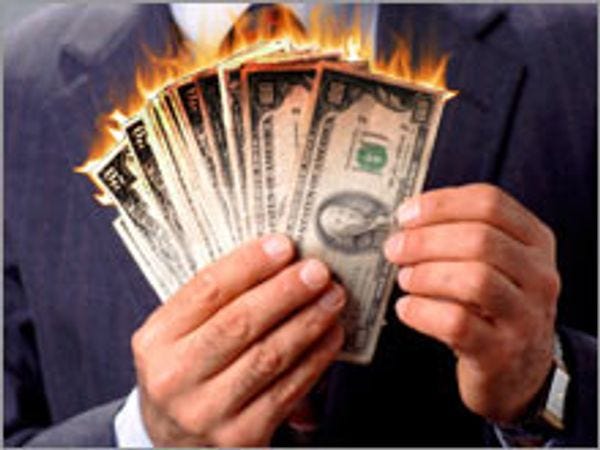Geithner Plan May Lose Remaining $1.21 In American Wealth
The stock market has rallied in response to Tim Geithner's latest details on his plan to fix America's Banks by giving them lots of money for their trash, which makes sense, because the new plan is good good GOOD for Wall Street! Imagine a world where the government put up like 85% of the financing for something that you wanted -- a robot, say -- and you only had to throw in 5%. But after realizing that the robot was, indeed a piece of crap, made from defaulted mortgage contracts instead of the usualmetals, the government lost all of that 85% investment, and you only lost 5%, so whatever. Let us look into this modern marvel of financial engineering known as the "Public-Private Investment Fund."
One of the main problems with the original TARP plan as devised by Hank Paulson -- aside from the fact that some toxic assets will always and forever be toxic assets, regardless of market conditions -- was that it offered no fair mechanism to price the toxic assets it was going to buy from banks. If some dumb mortgage-backed security was only going to fetch $1 in the market, that was precisely why it was considered "illiquid," because banks saw this as a firesale price that didn't reflect its actual value and was merely a symptom of a panicked economy. (WE'LL SEE.) So if the government were to buy these securities, they would have to offer above-market-value prices. And then the banks would never learn their lesson and run off with bags of money as the government figured out what to do with the massive hoard of horseshit it had just purchased for top dollar and was temporarily storing in Ben Bernanke's unfinished basement, next to the cave of rats.
The Geithner plan tries to circumvent this fair-pricing issue by having banks sell off their toxic assets in auctions, so then the price is determined by market forces and not simply by Fat Cats trying to high-ball Tim Geithner over the phone.
And once investors have set prices for these assets in auctions, their next move is to turn to the fucking government, pinch their index finger and pinky tips about four inches apart, and say, "I need this much."
At the core of the financing package will be $75 billion to $100 billion in capital from the existing financial bailout known as TARP, the Troubled Assets Relief Program, along with the share provided by private investors, which the government hopes will come to 5 percent or more. By leveraging this program through the Federal Deposit Insurance Corporation and the Federal Reserve, huge amounts of bad loans can be acquired.
The private investors would be subsidized but could stand to lose their investments, while the taxpayers could share in prospective profits as the assets are eventually sold, the Treasury said. The administration said that it expected participation from pension funds, insurance companies and other long-term investors.
The plan calls for the government to put up most of the money for buying up troubled assets, and it would give private investors a clearly advantageous deal. In one program, the Treasury would match, one for one, every dollar of equity that private investors invest of their own money in each “Public Private Investment Fund.”
What this amounts to, naturally, is a clusterfuck, but as long as it gets around Congress...
The Treasury Department offered this example to illustrate how the program would work: A pool of bad residential mortgage loans with a face value of, say, $100 is auctioned by the F.D.I.C. Private investors submit bids. In the example, the top bidder, an investor offering $84, wins and purchases the pool. The F.D.I.C. guarantees loans for $72 of that purchase price. The Treasury then invests in half the $12 equity, with funds coming from the $700 billion bailout program; the private investor contributes the remaining $6.
So yes, this public-private deal is MUCH MORE PUBLIC THAN IT IS PRIVATE. Whynotbuy anything if your exposure is a few percent? And since Wall Street actively enjoys watching American taxpayers get reamed, they'll love it when the government loses its entire "subsidy" (MOST OF THE PRICE) in this ludicrously leveraged non-recourse jaunt!
Oh and of course here is how the hedge funds will end up making shit-tons of money:
1. First the hedge fund buys an asset with a face value of $100 for $80. The hedge fund puts up $2.40, while the Fed contributes the rest, $77.60. Huge leverage.
2. The next day, the hedge fund re-runs the model and realizes that they overpaid the bank. Turns out, it was only worth $20 -- which was where the market had been, sans-government leverage.
3. The hedge fund loses it entire $2.40, and the taxpayer loses its entire $77.60.
4. BUT! The bank buys the asset back from the hedge fund at $20, while paying it a $5 million fee for its trouble.
5. The upshot: The banks sells high, buys low. The hedge fund collects a fee for holding the asset. And the taxpayer is screwed.
Although maybe Tim Geithner is a secret genius and this will buy us all homes again, who even knows.


